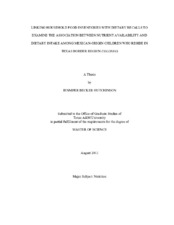| dc.contributor.advisor | Sharkey, Joseph R. | |
| dc.creator | Hutchinson, Jennifer Becker | |
| dc.date.accessioned | 2012-10-19T15:28:51Z | |
| dc.date.accessioned | 2012-10-22T18:00:24Z | |
| dc.date.available | 2012-10-19T15:28:51Z | |
| dc.date.available | 2012-10-22T18:00:24Z | |
| dc.date.created | 2011-08 | |
| dc.date.issued | 2012-10-19 | |
| dc.date.submitted | August 2011 | |
| dc.identifier.uri | https://hdl.handle.net/1969.1/ETD-TAMU-2011-08-9859 | |
| dc.description.abstract | The purpose of this study was to determine the relationship between household food inventories (HFI) and dietary recalls among Mexican-origin children (ages 6-11 years old) who reside in Texas border region colonias. Household food availability is a known influence upon children's diets; however, this population faces unique influences upon children's dietary intake and household food availability may not exhibit the same influence upon children's dietary intake that it does in other areas of the United States.
This study utilized promotoras (community healthcare workers native to the Texas border region) to collect data from participants due to their rapport with residents of the community. These promotoras collected a series of surveys, HFI's and 24-hour dietary recalls with each mother-child dyad participant.
Data from the HFI-s and 24-hour recalls were entered into the Nutrition Data System for Research (NDS-R) from the University of Minnesota and the nutrient profiles for each were analyzed. The HFI data was then adjusted for household composition to obtain a more accurate representation of what nutrients are available to each specific member of the household.
After analysis, participant children reported living in households with 5.7 adults and children (range 3-10). All children participated in school breakfast and lunch programs. Age- and gender-specific body mass index (BMI) percentiles indicated that 42% were considered overweight or obese. Lower food security was associated with greater energy, total sugar, and added sugar intakes. The largest correlations between HFI's and 24-hour intakes were for total protein, total sugar, sodium, and added sugar. Sodium was the only nutrient with a significant correlation between household availability and children's dietary intake. HFI was independently associated with greater intake of sodium and lower intakes of total sugar and added sugar.
Results show a relationship between household food availability and children's dietary intake. However, at the nutrient level, this association is only statistically significant for sodium and almost significant for total sugar. Colonia children are likely eating many meals outside of the home; the traditional HFI might not be useful in determining what foods are available for these children to eat. | en |
| dc.format.mimetype | application/pdf | |
| dc.language.iso | en_US | |
| dc.subject | children | en |
| dc.subject | obesity | en |
| dc.subject | colonias | en |
| dc.subject | household food inventory | en |
| dc.title | Linking Household Food Inventories with Dietary Recalls to Examine the Association between Nutrient Availability and Dietary Intake among Mexican-origin Children who Reside in Texas Border Region Colonias | en |
| dc.type | Thesis | en |
| thesis.degree.department | Nutrition and Food Science | en |
| thesis.degree.discipline | Nutrition | en |
| thesis.degree.grantor | Texas A&M University | en |
| thesis.degree.name | Master of Science | en |
| thesis.degree.level | Masters | en |
| dc.contributor.committeeMember | McIntosh, William A. | |
| dc.contributor.committeeMember | Kubena, Karen S. | |
| dc.type.genre | thesis | en |
| dc.type.material | text | en |


